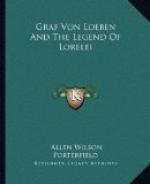And then, after contending that Brentano’s RheinmAerchen,[41] which, though written before 1823, were not published until 1846, must have given Heine the hair-combing motif, Thorn says: “Also kann nur Brentano das Vorbild geliefert haben.” This cannot be correct. What is, on the contrary, at least possible is that Heine influenced Brentano.[42] The RheinmAerchen were finished, in first form, in 1816. And Guido GOerres, to whom Brentano willed them, and who first published them, tells us how Brentano carried them around with him in his satchel and changed them and polished them as opportunity was offered and inspiration came. It is therefore reasonable to believe that Heine helped Brentano to metamorphose his Lorelei of the ballad, where she is wholly human, into the superhuman Lorelei of the RheinmAerchen where she does, as a matter of fact, comb her hair with a golden comb.[43]
And now as to Loeben: Did Heine know and borrow from his ballad? Aside from the few who do not commit themselves, and those who trace Heine’s poem direct to Brentano, and Oscar F. Walzel to be referred to later, all commentators, so far as I have looked into the matter, say that he did. Adolf Strodtmann said[44] it first (1868), in the following words: “Es leidet wohl keinen Zweifel, dass Heine dies Loeben’sche Ballade gekannt und bei Abfassung seiner Lorelei-Ballade benutzt hat.” But he produces no proof except similarity of form and content. Of the others who have followed his lead, ten, for particular reasons, should be authorities: Franz Muncker,[45] Karl Hessel,[46] Karl Goedeke,[47] Wilhelm Scherer,[48] Georg MUecke,[49] Wilhelm Hertz,[50] Ernst Elster,[51] Georg Brandes,[52] Heinrich Spiess,[53] and Herrn. Anders KrUeger.[54] But no one of them offers any proof except Strodtmann’s statement to this effect.
Now their contention may be substantially correct; but their method of contending is scientifically wrong. To accept, where verification is necessary, the unverified statement of any man is wrong. And, that is the case here. Elster’s note is of peculiar interest. He says: “Heine schloss sich am nAechsten an die Bearbeitung eines Stoffs an, die ein Graf LOeben 1821 verOeffentlichte.” The expression “ein Graf LOeben” is grammatical evidence, though not proof, of one of two things: that Loeben was to Elster himself in 1890 a mere name, or that Elster knew Loeben would be this to the readers of his edition of Heine’s works. Brandes says: “Die Nachahmung ist unzweifelhaft."[55] His proof is Strodtmann’s statement, and similarity of content and form, with special reference to the two rhymes “sitzet-blitzet” that occur in both. But this was a very common rhyme with both Heine and Loeben in other poems. How much importance can be attached then to similarity of content and form?




